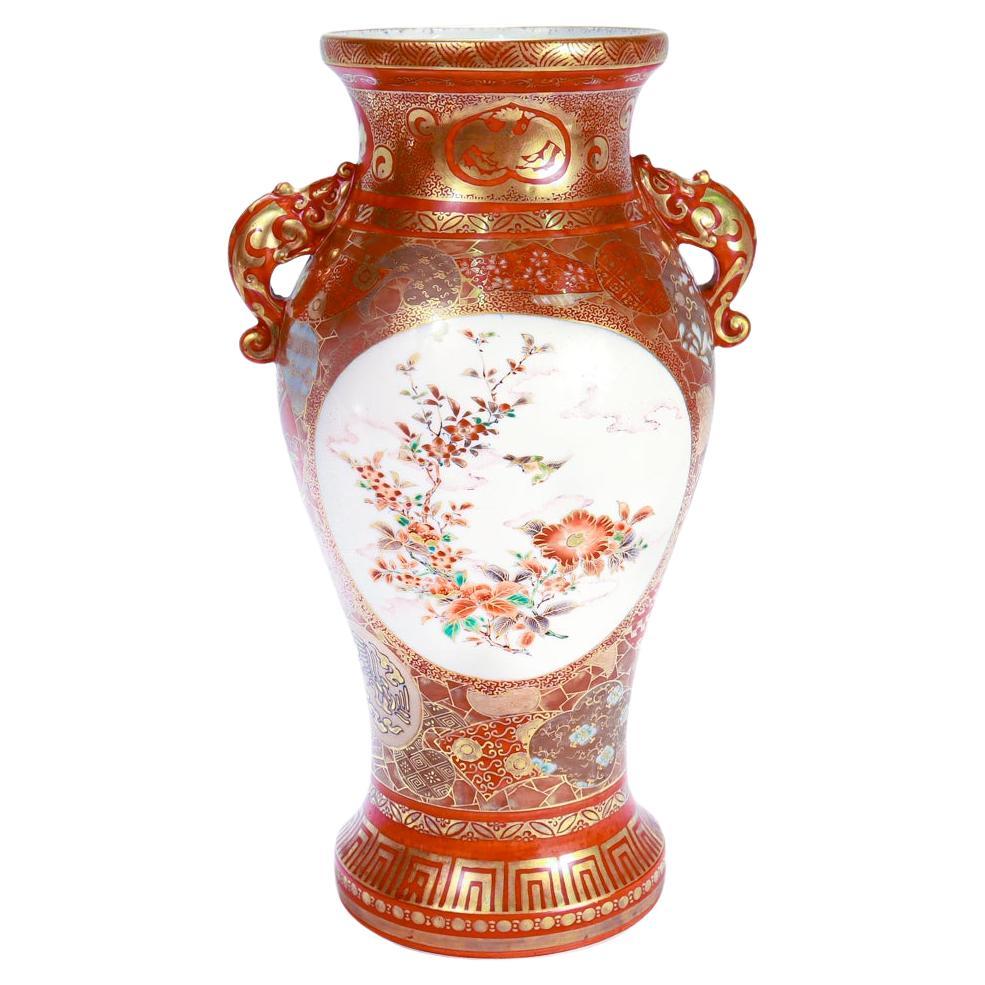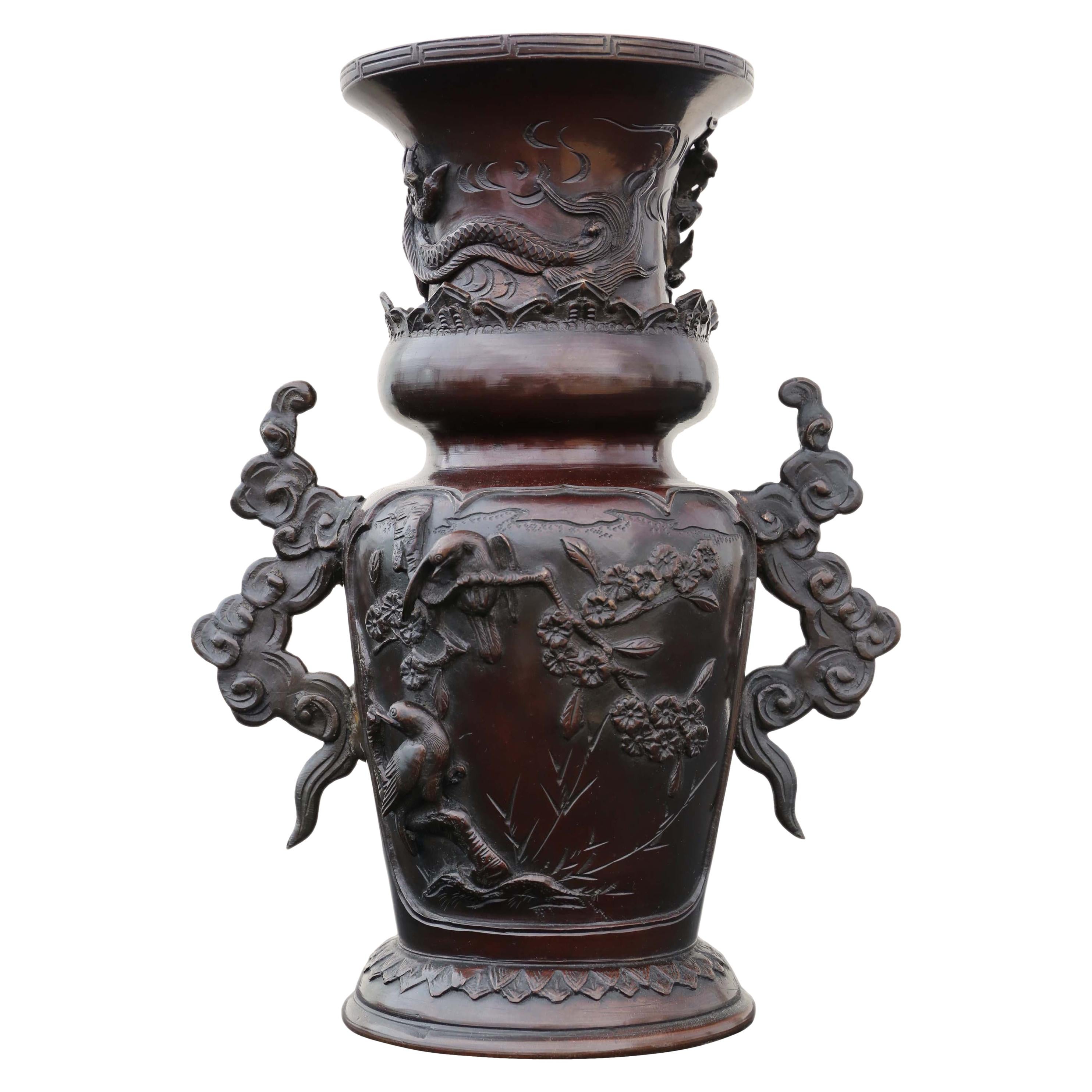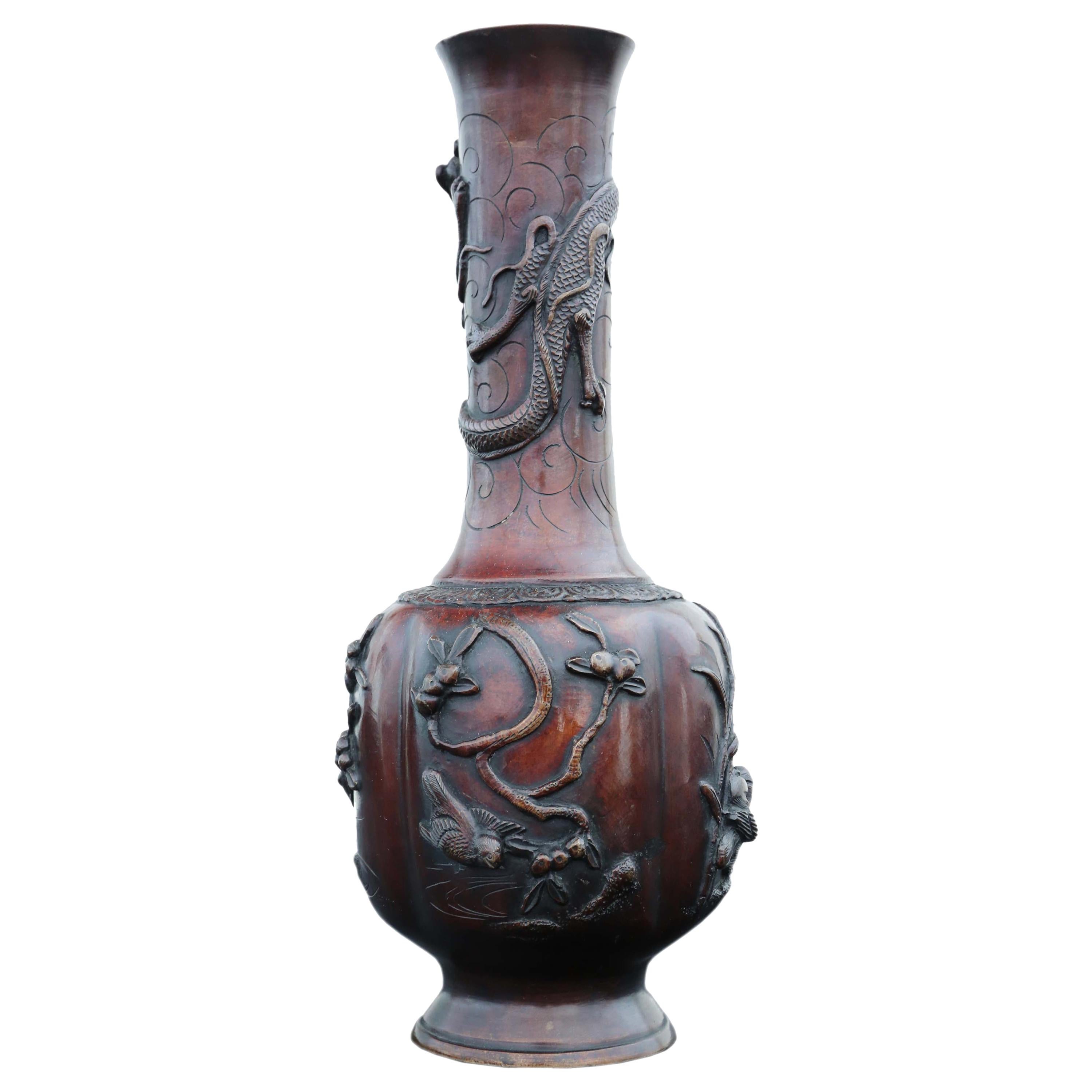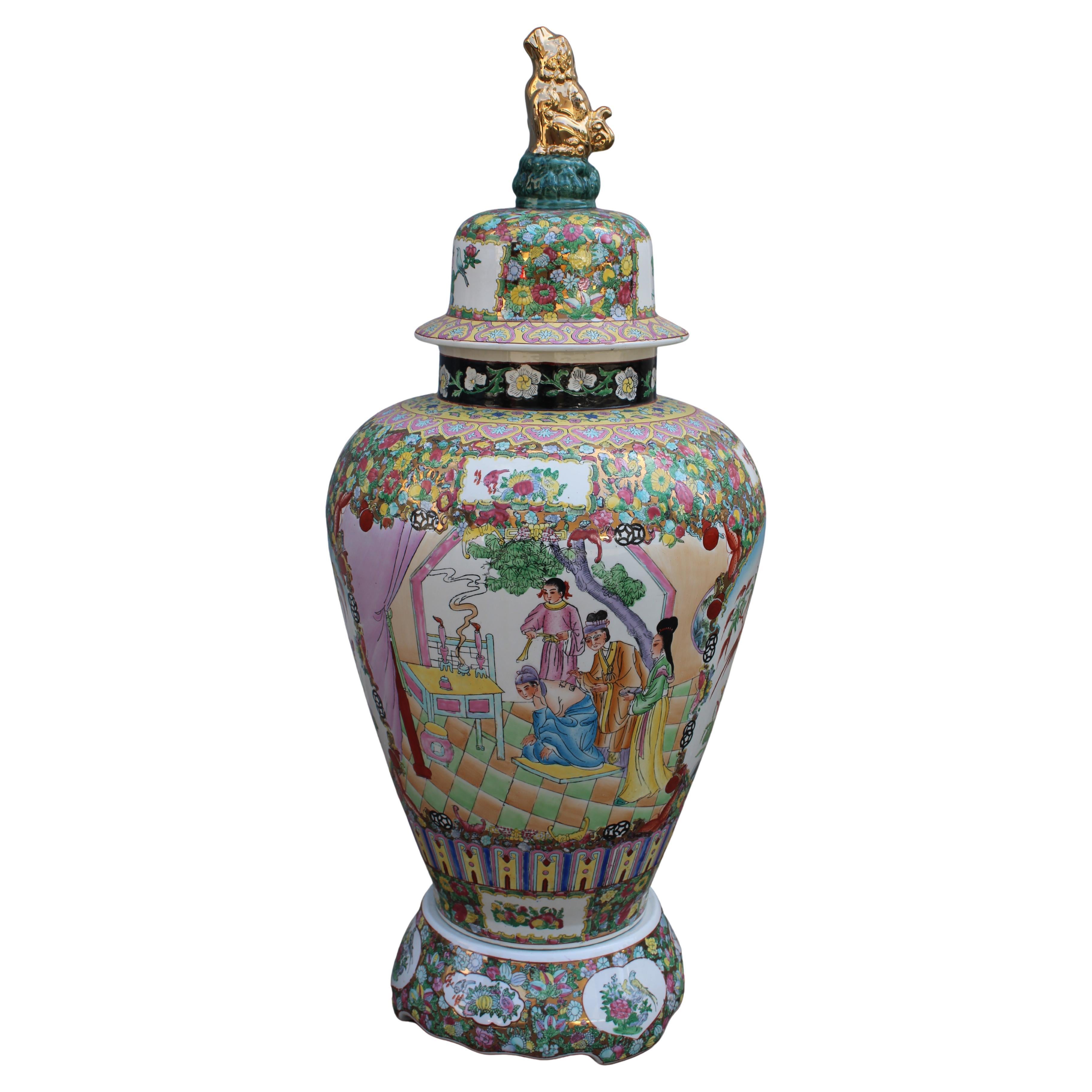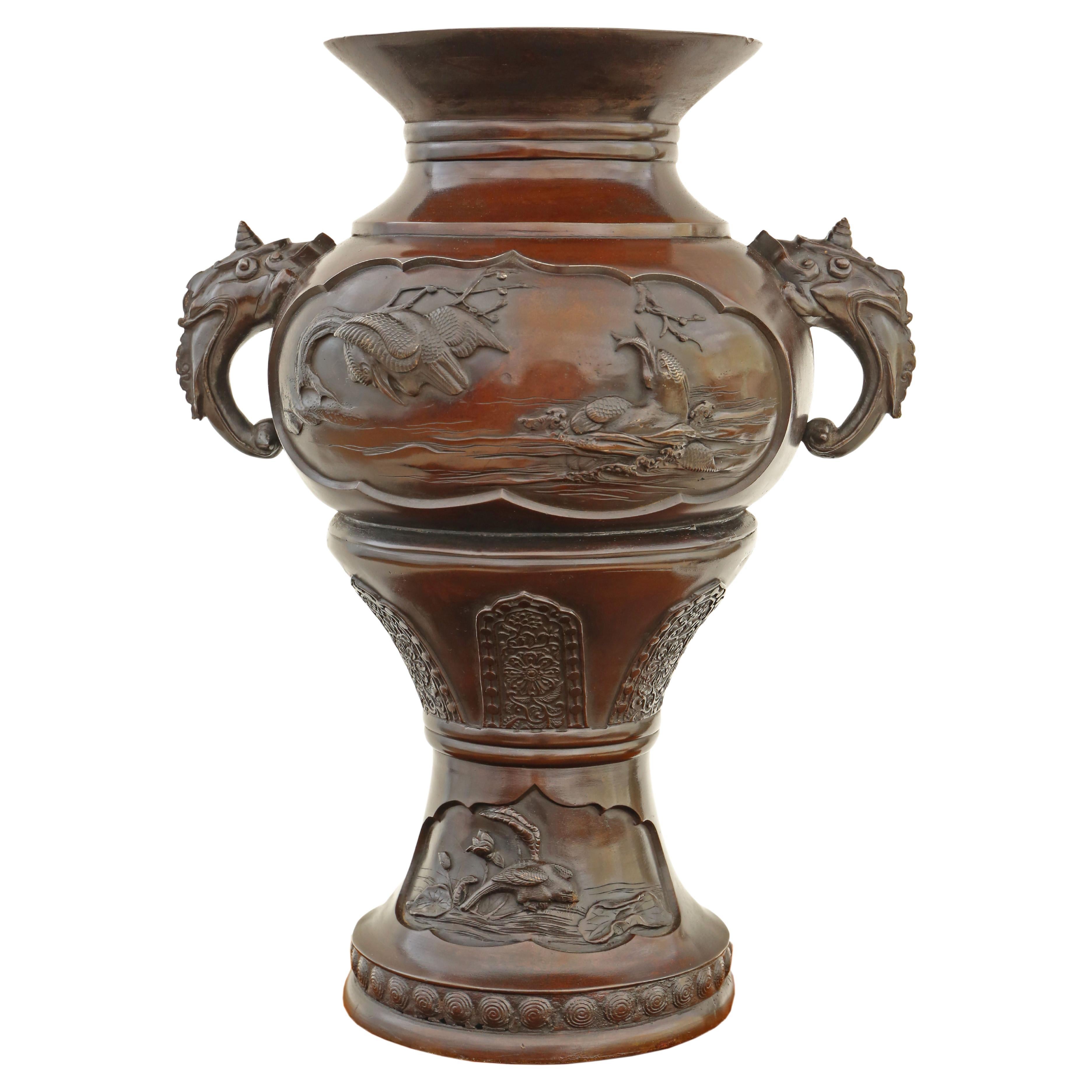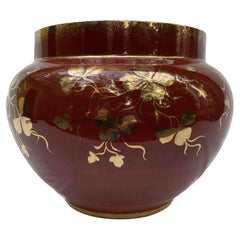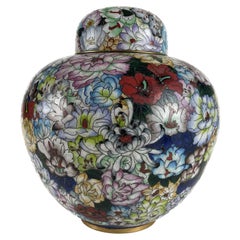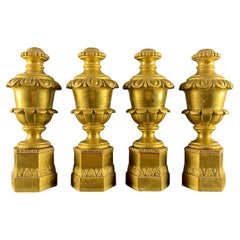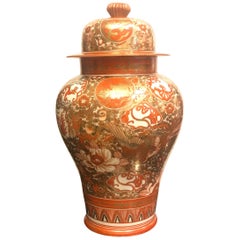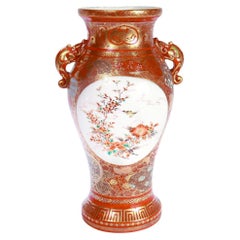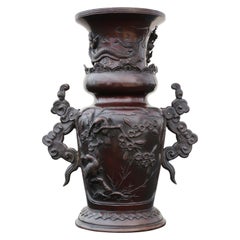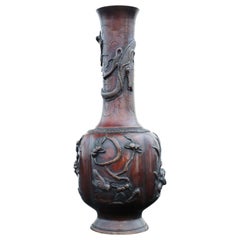Items Similar to Large Red and Gold Vase In Porcelain Kutani Meiji Period with Small Table
Video Loading
Want more images or videos?
Request additional images or videos from the seller
1 of 21
Large Red and Gold Vase In Porcelain Kutani Meiji Period with Small Table
$4,197.13
£3,122.24
€3,500
CA$5,747.30
A$6,390.22
CHF 3,336.62
MX$77,784.50
NOK 42,573.80
SEK 39,889.62
DKK 26,643.57
Shipping
Retrieving quote...The 1stDibs Promise:
Authenticity Guarantee,
Money-Back Guarantee,
24-Hour Cancellation
About the Item
Monumental Japanese Lidded Vase In Kutani Porcelain Meiji Period Late 1800s red ground with rich gold decoration of flowers, birds and people within reserves.
94 cm tall this imposing Porcelain Vase of the Meiji period is an outstanding example of Japanese art reflecting the rich ceramic tradition of Kutani, developed in the 17th century in the city of the same name. This antique vase from the late 1800s is distinguished by its vibrant red background and elaborate gold decoration, which features a riot of flowers, polychrome birds and scenes of everyday life.
The main scene depicts two ladies in a playful moment, while another female figure shows a drawing to a seated child, capturing attention for her liveliness and artistry. The complexity of the decoration is such that it is difficult to describe it completely, highlighting the craftsmanship of the artisans of the time.
The vase has a lid decorated with a Pho dog, standing on a rock, a symbol of protection and good luck. It is important to note that there are some restorations on the edge of the cap, as well as small felures, EVIDENTIATED IN THE PHOTOGRAPHS.
The vase sits on a finely carved and lacquered base made of red-stained wood, which further enhances its beauty and preciousness.
The overall dimensions of the object are significant: the carved pedestal is a small table with shelves and measures 76.5 cm in height, with a base having a side of 41 x 41 cm, while the vase itself is 61 cm high and has a diameter of 47 cm. The cap, which is 31.5 cm high and 28.5 cm in diameter, completes the ensemble.
Finally, the vase is signed with a gold ideogram on a red background, visible at the bottom, testifying to the authenticity and value of the work.
The Meiji period, from 1868 to 1912, is known for its profound cultural and artistic transformations in Japan, making this vase not only a decorative object but also a piece of history.
Period: end 1800
Height with wooden base: 170 cm
Diameter: 47 cm / 18.5 in
For the export from Italy of an art object that is more than 50 years old, a government export license called BELLE ARTI must be applied for. the issuance of such a license takes about 2 to 3 weeks, to be added to the order processing time.
- Dimensions:Height: 66.93 in (170 cm)Diameter: 18.51 in (47 cm)
- Style:Meiji (Of the Period)
- Materials and Techniques:
- Place of Origin:
- Period:
- Date of Manufacture:Late 19th century
- Condition:Repaired. Wear consistent with age and use. A small felure, restoration, and minimal defects consistent with age are highlighted in the photographs.
- Seller Location:Milano, IT
- Reference Number:Seller: a14171stDibs: LU2160343422472
About the Seller
5.0
Vetted Professional Seller
Every seller passes strict standards for authenticity and reliability
Established in 1990
1stDibs seller since 2016
182 sales on 1stDibs
Typical response time: 1 hour
Associations
International Confederation of Art and Antique Dealers' Associations
- ShippingRetrieving quote...Shipping from: Milano, Italy
- Return Policy
Authenticity Guarantee
In the unlikely event there’s an issue with an item’s authenticity, contact us within 1 year for a full refund. DetailsMoney-Back Guarantee
If your item is not as described, is damaged in transit, or does not arrive, contact us within 7 days for a full refund. Details24-Hour Cancellation
You have a 24-hour grace period in which to reconsider your purchase, with no questions asked.Vetted Professional Sellers
Our world-class sellers must adhere to strict standards for service and quality, maintaining the integrity of our listings.Price-Match Guarantee
If you find that a seller listed the same item for a lower price elsewhere, we’ll match it.Trusted Global Delivery
Our best-in-class carrier network provides specialized shipping options worldwide, including custom delivery.More From This Seller
View AllGuido Andlovitz Red and Gold Deco Vase 1930s Italian Ceramic Society Laveno
By Guido Andlovitz
Located in Milano, MI
Guido Andlovitz Red hand-painted vase with gold floral motifs, Gold Verbanum Stone SCI Laveno of flattened spherical shape with a pot-bellied body and the wide neck formed by a strai...
Category
Vintage 1930s Italian Art Deco Planters, Cachepots and Jardinières
Materials
Ceramic
Pair of Chinese Hexagonal Vases 19th Century Qing Dynasty 60 cm High
Located in Milano, MI
Pair Nineteenth Century Quing Dynasty Hexagonal Chinese Vases decorated in polychrome with peonies and birds with two handles formed by fruit and racemes. In the sides, vertically, w...
Category
Antique Late 19th Century Chinese Qing Antiquities
Materials
Porcelain
Cloisonné vase with lid Flower and butterfly decoration China circa 1950s
Located in Milano, MI
Cloisonné vase with lid with rich floral decoration, peonies and butterflies, light blue background of the mid-twentieth century, of Chinese origin. Belly-shaped, of remarkable qu...
Category
Mid-20th Century Chinese Chinese Export Antiquities
Materials
Metal, Enamel
Gilded Italian Carved Wood finials 1800 Set of Four Lamp Bases
Located in Milano, MI
Italian Carved And Gilded Wood finials 1800s, set of four vases on hexagonal plinth with vegetal pastille carving frames, set of four turned and carved linden wood vases in the round...
Category
Antique Early 19th Century Italian Empire Vases
Materials
Gold Leaf
Italian Empire Vase Applique in Gilded Carved Wood Circa 1780
Located in Milano, MI
Gilded Empire Applique Lamp Late 1700s obtained from a carved wooden palm vase gilded in fine gold, converted into a wall sconce for use as a wall lamp. In the back of this lamp one ...
Category
Antique 18th Century and Earlier Italian Empire Wall Lights and Sconces
Materials
Gold Leaf
Italian Ceramic Vase with Marina and Vessels Umbrella Stand Perugia 1952
Located in Milano, MI
A stunning large Italian vase, suitable for flowers or umbrella stand, an Italian Ceramic artwork decorated in Relief with a sea landscape , vessels and clouds. The vase has two turquoise floral bands, one upper and one lower with raised and graffitied foliage...
Category
Mid-20th Century Italian Vases
Materials
Ceramic
You May Also Like
Antique Meiji Period Kutani Japanese Porcelain Temple Jar
Located in Lambertville, NJ
Antique Meiji period Japanese porcelain temple jar with intricate hand painted decoration and gilt. The jar in Classic Kutani colors with floral and phoenix birds all over the top an...
Category
Antique 1880s Japanese Meiji Ceramics
Materials
Porcelain
Antique Japanese Meiji Period Kutani Porcelain Vase by Shoundo / Matsumoto Sahei
Located in Philadelphia, PA
A fine antique Japanese Meiji period Kutani porcelain vase.
By Matsumoto Sahei/Shoundo.
In an aka-e style decorated throughout in iron red with extensive gilt accents.
There are cartouches to either side both with branches of red flower with a backdrop of clouds on a white ground.
With 2 figural dragon finial handles.
Marked to the base with '九谷松雲堂製' which translates as 'Made by Shoundo of Kutani'
Matsumoto Sahei (1851-1918) was a master potter who enjoyed success & recognition during his era. In 1876, Sahei received the artist name Shoundo from the nanga painter Tokuda Kansho - he would use that title for nearly 20 years until passing it onto his son as his successor in 1893. Sahei also has the distinction of taking Tokuda Yasokichi I as an apprentice when the latter was 17-years-old. The Tokuda family is perhaps one of the most famous families of Japanese ceramics: Yasokichi I is credited with revitalizing the lost art of ko-Kutani and Yasokichi I, II, & III were all recognized as "Living National Treasures" during their lifetimes.
Shoundo exhibited internationally numerous times at the tail end of the 19th Century. The Keisei Isogaya Museum of Art (which specializes in Meiji Kutani) has a vase of Sahei's that was exhibited in the Philadelphia Centennial Exhibition of 1876. He is listed as exhibiting a wide variety of porcelain goods at the 1878, 1889, and 1900 Paris World Exhibitions. He is also listed as exhibiting 'incense burners & porcelain' at the World's Columbian Exhibition held in 1893 in Chicago. The pair of vases that Sahei exhibited in Paris in 1900 bear a strong resemblance to this pair.
Simply a wonderfully rare Japanese porcelain...
Category
Early 20th Century Japanese Meiji Ceramics
Materials
Porcelain
Antique Japanese Bronze Vase Early Meiji Period
Located in Wisbech, Cambridgeshire
Early Japanese Meiji period bronze vase. Raised dragon with birds and cloud handles.
Would look amazing in the right location. The very best color an...
Category
Antique 19th Century Meiji Vases
Materials
Bronze
$955 Sale Price
30% Off
Antique Meiji Period Japanese Bronze Vase
Located in Wisbech, Cambridgeshire
Japanese Meiji period bronze vase.
Would look amazing in the right location. The very best color and patina.
Overall maximum dimensions: 31 cm high x 14 cm diameter (inner mouth 4....
Category
Antique 19th Century Meiji Vases
Materials
Bronze
$955 Sale Price
30% Off
Large Chinese Vase with 24KT Gold Decorations and Parts Mid-century Asian Design
Located in Palermo, Sicily
Large Vase with base and lid China 1950s. of great quality and execution.
Category
Vintage 1950s Chinese Chinoiserie Planters, Cachepots and Jardinières
Materials
Porcelain
Antique Large Fine Quality Japanese Oriental Bronze Urn Vase Meiji Period
Located in Wisbech, Cambridgeshire
Antique large 17" fine quality Japanese Oriental bronze urn vase Meiji Period 19th century. Signed artist piece.
Would look amazing in the right location and make a fabulous centr...
Category
Antique 19th Century Metalwork
Materials
Bronze
$1,146 Sale Price
30% Off
More Ways To Browse
Rosso Antique
Japanese Cane
Arte Ceramica
Rosso Antico
Japanese Tea Ceremony Ceramics
Antique Chinese Blue And White Porcelain Bowl
Ming Dragon
Asian Ceramic Pots
Shipwreck China
Antique Chinese Coins
Blue And White Canton China
Chinese Blanc De Chine
Qing Dynasty Bowl
Edo Period Bowl
Antique Rose Canton China
Chinese Qing Dog
Japanese Plum Blossom
Qianlong Dish

